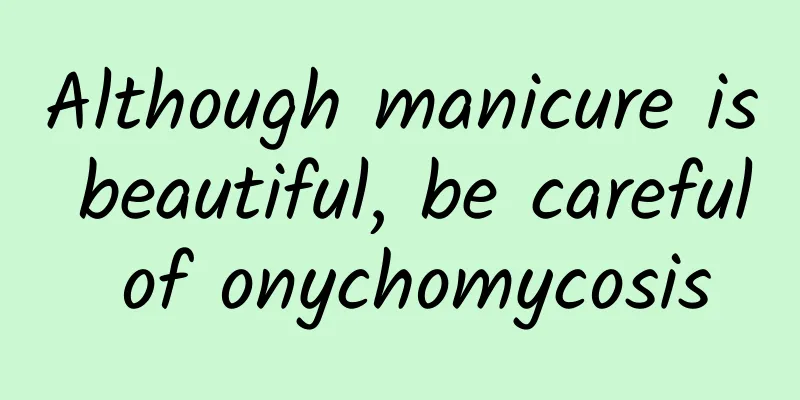Although manicure is beautiful, be careful of onychomycosis

|
Reviewer: Zhang Shuyuan, Chief Physician, Beijing Huayi Integrated Traditional Chinese and Western Medicine Dermatology Hospital In order to make their hands more beautiful, many women like to stick false nails of different colors and patterns, as well as sequins of various materials, on their nails to make their fingers look more beautiful and slender. However, there are many products and materials used in manicures, and there are often hidden health risks behind them. If the operation is not done properly and the equipment is not kept clean, the "manicure" will turn into onychomycosis over time. Figure 1 Copyright image, no permission to reprint 1. Why do nail art patients suffer from onychomycosis? During the manicure process, the first step is to file the nails thinner with a file, then apply base coat for a base coat, and finally stick on false nails with various exquisite patterns and shapes. In the process of filing thin nails, the protective layer of nails can be easily damaged. Like teeth, nails have a layer of enamel-like protective material attached to their surface. After the surface layer of nails is filed off, they will lose their resistance to fungal invasion in nature. Applying base coat and nail polish is like providing a protective umbrella for fungi hiding in the nail bed; coupled with the erosion of chemical coatings on the nails, fungi multiply in large numbers, eventually leading to fungal infection of the nail plate. In addition, if nail tools are used by multiple people and are not professionally disinfected, it is easy to cause cross-infection of fungi during use. If one of the customers has onychomycosis, it can be inadvertently transmitted to others through the nail tools. Figure 2 Copyright image, no permission to reprint 2. What is onychomycosis? Onychomycosis, also known as "onychomycosis", is a common infectious disease in dermatology caused by fungi such as dermatophytes, yeasts, and non-dermatophyte molds invading the nail plate and subungual nails. The main manifestations are thickening of the nails, black-gray color or yellow-white spots, and loss of luster. The lesions begin at the distal end, side edge or fold of the nail, with abnormal color and shape. In the early stages of infection, onychomycosis does not cause obvious inflammation such as redness, swelling, and pain, so it is not easy to detect. In addition, the onychomycosis process is generally slow, and by the time it is diagnosed, the disease is often already very deep. Once the fungus invades the nail plate, it will hide deep in the nail bed. When they infect under the nail cover, they will frantically absorb nutrients from the nail plate, thereby hindering the normal growth of the nail, and causing the nail plate to lose its luster. Some nails become rough and turbid, some become brittle and thick, and some have uneven surfaces. In severe cases, it can cause nails to fall off, which is unacceptable for women who love beauty. So what do fungal nail infections look like? 3. Onychomycosis is divided into 5 types Onychomycosis is generally manifested by turbidity, hypertrophy, uneven surface, discoloration, atrophy, shedding, and curling of the nail plate. Depending on the pathogen causing the infection, onychomycosis is usually divided into five types: 1. Distal lateral subungual onychomycosis. This type is the most common. The pathogen first invades the distal subungual nail bed and then invades the subungual nail plate. Due to the thickening of the nail plate, the nail plate may be tilted upward or cause nail separation. If the disease lasts for a long time, the distal nail plate will be missing, brittle, and fall off, and the proximal residual nail will remain like a tree stump. 2. Proximal subungual onychomycosis. This type is more common in patients with immune deficiency, such as HIV-infected patients, leprosy patients, etc. The pathogenic bacteria invade the cuticle at the root of the nail and the proximal nail plate and nail bed, causing the nail plate to become turbid, thickened, rough, uneven, and often accompanied by paronychia. 3. Superficial white onychomycosis. This type is caused by pathogens that directly invade the surface of the nail plate. The lesions are initially white islands smaller than 1 mm, which gradually expand and merge into white cloud-like turbidity. The surface of the nail plate is uneven or deformed, and may also disintegrate. 4. Full nail dystrophy onychomycosis. This type can be aggravated and evolved from the above three types of lesions. The entire nail plate is eroded, destroyed, and falls off, and accumulated keratin hyperplasia can be seen on the surface of the nail bed. 5. Intra-nail onychomycosis. This type is rare in clinical practice and has not been reported in China. The damage is limited to the nail plate and does not invade the subungual area. The nail plate is white or grayish white, with no obvious thickening or atrophy, and no obvious inflammation. From the above content, it is not difficult to see that onychomycosis is getting worse step by step. If we find the symptoms of bleeding onychomycosis on our fingers in our lives, we must treat it in time, because the harm of onychomycosis cannot be underestimated. Let's take a look at the harms of onychomycosis. Figure 3 Copyright image, no permission to reprint 4. The harm of onychomycosis 1. Affects appearance and social interaction. Onychomycosis on the hands not only affects appearance, but also causes psychological pressure to others when we shake hands with them, which affects normal social interaction to a certain extent. 2. Psychological barriers. Since onychomycosis is prone to recurrence, is not easy to be cured, and affects the appearance, our psychology will be more or less affected, making us prone to depression, inferiority, impatience and other emotions. 3. There are many complications and it is easy to become a source of infection. In addition to causing complications such as paronychia and nail bed inflammation, onychomycosis can also cause infection in other parts of the body or be transmitted to others through indirect contact if the patient is not careful. Onychomycosis is very harmful to our lives, so we must keep our hands and feet clean and dry in daily life. When choosing nail polish, we must identify the brand and do not use or use less inferior nail polish. In addition, when trimming fingernails and toenails, be careful not to cut them too short. Also, be careful not to touch the personal belongings of sick people to avoid cross infection. |
>>: White spots appear on your skin? Don't worry, it may not be vitiligo
Recommend
Estrogen secretion manifestations
Estrogen is a female hormone that girls will secr...
What are the advantages and disadvantages of women's foot bath
Nowadays, people are paying more and more attenti...
Can pregnancy be detected 9 days after ovulation?
There are many ways to test for pregnancy. You ca...
Stop it! If these parts of your body are too clean, you are harming yourself!
We have been taught since childhood Be hygienic a...
Treatment of malignant uterine polyps
I believe that everyone is familiar with the symp...
What causes women's legs to get hot?
Some women always feel that their legs are prone ...
If you want to eat beauty-enhancing and energy-replenishing soup in winter, okay, I’ll introduce it to you!
After living in the city for a long time, our qua...
Three major "killers" that harm women's uterus
The uterus is unique to women and is a part of th...
Girls learn to swim
In order to ensure their physical health, many pe...
How do girls get rid of body odor? These remedies are very effective
Body odor is bothering many people. Some people b...
HCG blood value comparison table
I believe that many female friends who are prepar...
What causes chest pain in women?
Many women experience chest pain. If the chest pa...
Brown blood after menstruation
Many female friends actually do not pay attention...
How to eat when there is a little blood in the vagina?
In daily life, many women will lack the protectio...
What to eat during menstrual period to enlarge breasts
Breast augmentation is an eternal topic. Many wom...









